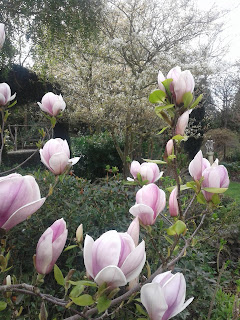Almost the end of August which means we should be leaving winter behind, BUT we had a few good frosts last week which had my small seedlings all a quiver, thankfully with frost cloth protection they are hung in and will soon be ready to pot on into punnets. Plants have been putting on slow growth in the last couple of weeks. Weed growth is not so slow, chickweed and bidibid are romping away but at this stage are very easy to pull out before they produce seed.
Magnificent magnolias are center stage right now, very worth while trees to grace any medium sized garden. Beautiful bare branching through winter, stunning blooms and then large attractive leaves take them through to winter, they grow well with azaleas, rhododendrons and camellias because they all prefer an acid soil. There are many different choices in tree size and blooms, for the smaller garden Magnolia billowing cloud is White / Pink Upright habit- Hgt / width 3m x 2,5m, for a larger garden Magnolia Charles Raffill soft Pink upright habit, Hgt/wdth 7m x 5m, so many different beauties to choose from in Garden centers now.
Lavenders can be cut back now as they begin to put out new growth, really old woody bushes can be cut back hard to encourage new lower growth, if they do not respond it may be time to replace them. Newly planted lavender plants just need a hair cut and fed manure enriched compost plus a little lime.
Climbers are in bud now ready to do their spring thing so when trimming watch you are not cutting off new buds, Jasmines can get knocked by frosts (yet), leave a bit longer until sure frosts are over before trimming them.
Roses: As I mentioned last week feed roses they are moving fast now, well worth the effort to minimize spaying needed later on.
Sow seeds under cover, seed packs that recommend spring sowing should germinate now. I sow seeds in trays of peat, potting mix and compost combined with a layer of seed raising mix on the top. Once planted cover trays with plastic or glass, using spacers to let air circulate.
Lawns will be greening up now and will need some attention after Winter dormancy. Water on (watering can) sulphate of iron to eradicate moss, once moss has turned black rake out. The presence of moss in lawns indicates poor growing conditions for grass. Moss grows where grass cannot survive, such as nutrient poor soil, soil with high acidity, soil that is compacted or drains poorly or where there is excessive shade or thatch accumulation. Give the older lawns a good rake to lift any thick thatch, cut and then aerate to improve drainage. Once all this has been completed, over the next 2 to 3 weeks apply lawn fertiliser during rain to keep them spring green. The word is our summer will be a dry one and lawns are the first to suffer so give them a good start now.
Vegetables: If you are planting out a veg garden seedlings are best planted later in the day when the heat is out of the sun, watering however is best done at the start of the day allowing time for soil to warm before the night chill. In area's you do not plan to plant for a while sow a green crop to add humus to the soil, Mustard, lupine, barley or wheat they will germinate in no time then dig in when lush, soft and green, don't let it get to the flowering, stalky stage because it takes too long to break down.
Plenty of seed potatoes on offer now for you to get sprouting, early varieties can go in and should show leaf in about a month when frosts are over. Keep frost protected if they show leaf early.
Fruit: This is also the time to give fruiting shrubs and trees a dressing of pot ash enriched fertiliser to help with fruiting. As mentioned last week deciduous fruit trees and everything in the way of small fruit should be planted in August / early September at the latest. Keep an eye on peach tree buds, spraying with copper for leaf curl should be done just on bud break.
Cheers, Linda.






